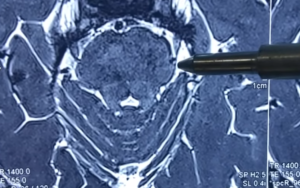The diagnosis of Trigeminal Neuralgia is primarily made based on your description of pain.
Do I have Trigeminal neuralgia?
If you have:
- sudden, electric-shock like bursts of pain
- affecting a part of one side of the face,
- especially if there are trigger factors,
you most likely have Trigeminal Neuralgia.
MRI for diagnosis of trigeminal neuralgia
Certain tests need to be performed to rule out underlying causes.
The commonest is a high-quality MRI of the brain with special sequences at the brain-stem. These are called CISS sequences, and are done and interpreted by specialized radiologists.
The MRI is helpful in determining if there is a blood vessel, tumor, cyst or any other lesion pressing on the trigeminal nerve. The commonest cause of Trigeminal neuralgia is blood vessel compression on the Trigeminal nerve.

MRI can also help in diagnosing multiple sclerosis, which can occasionally be one of the causes of Trigeminal Neuralgia.
How long does MRI take?
Normally, anaesthesia is not required for MRI of the brain with special sequences ; it generally lasts between 30 and 45 minutes.
What tests need to be done other than MRI?
You will need further investigations if you are scheduled for a procedure like MVD surgery, or RFLG .
You may be advised to get these tests, other than the MRI:
- blood tests,
- heart-related tests,
- hearing tests (not always),
- other tests to assess your fitness for the procedure.